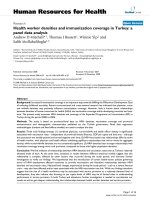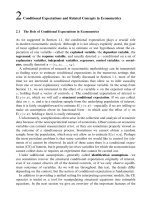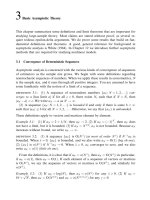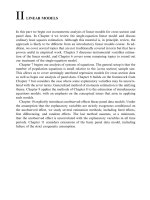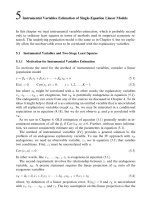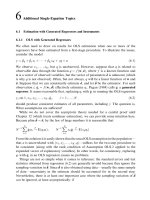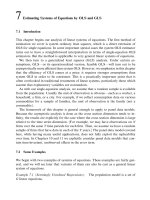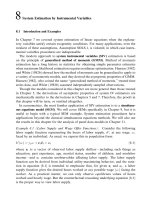Time Series and Panel Data Analysis Year 4 ENG
Bạn đang xem bản rút gọn của tài liệu. Xem và tải ngay bản đầy đủ của tài liệu tại đây (86.7 KB, 4 trang )
TIME SERIES AND PANEL DATA ANALYSIS
Lecturers
Sergey V. Gelman
Class Teacher
Islam Utyagulov
Andrei A. Sirchenko
Course description
Time Series and Panel Data Analysis (intermediate level) is a one-semester course designed for fourth
year ICEF students. The main objective of the course is to prepare the students to do their own applied
work, in particular on their bachelor's diploma. The course is divided into two parts: the first part --Time Series theory and methods --- is taught by Sergey Gelman, and the second part --- Panel Data
Analysis --- is taught by Andrei Sirchenko. The prerequisites of the course are Statistics and
Econometrics. The knowledge of economic theory and computer-based information systems is
necessary as well. The course is taught mainly in English, some of the classes may be taught in
Russian.
Teaching methods
The following methods and forms of study are used in the course:
1 Lectures
2 Practical sessions in the computer lab class (the main problems in home assignments are
discussed)
3 Learning-by-doing in the computer lab (doing home assignments using Excel, STATA and
Econometric Views, working with economic data, doing research on the web)
4 Self-learning with literature
5
Assessment
1) Homework assignments
2) Midterm exam (at the end of the first part of the course)
3) Essay (4-5 pages)
4) Final exam
Grade determination
This course includes two written exams, one essay and several homework assignments. The final grade
is determined by the midterm exam (35%)? The final exam (35%)? The homework assignements
(10%)? And the essay (20%).
Main reading
Time Series Analysis
1) Enders W. Applied Econometric Time Series. 2nd ed., John Wiley and Sons, Inc., 2004 (WE)
2) Christoffersen, P. F. Elements of Financial Risk Management. Academic Press, London 2003
(PC)
3) Diebold, F.X. Elements of forecasting, Thomson South-Western, Canada 2006 (FD).
4) James D. Hamilton. Time Series Analysis. Princeton University press, 1994.
5) Kantorovich G. G. Lecture notes for the course "Time Series Analysis" (in Russian).
Ekonomicheskij zhurnal VShE, 2002.
Panel Data Analysis
1) A. Colin Cameron and Pravin K. Trivedi, Microeconometrics: methods and applications.
Cambridge U.P., 2005. (CT)
2) Wooldridge J. M., Econometric analysis of cross section and panel data. The MIT Press, 2002.
(WOO)
3) A. Colin Cameron and Pravin K. Trivedi, Microeconometrics using STATA. Revised edition,
STATA Press, 2010
Additional reading
Time Series Analysis
1) Tsay, R., Analysis of Financial Time Series, John Wiley and Sons, 2002
2) Maddala, G.S. And Kim In-Moo. Unit Roots, Cointegration, and Structural Change.
Cambridge University Press, 1998
3) P. J. Brockwell, R. A. Davis, Introduction to Time Series and Forecasting. Springer, 1996
4) J. Johnston, J. DiNardo. Econometric Methods. McGraw-Hill, 1997.
5) W. Charemza, D. Deadman. New Directions in Econometric Practice. Edward Elgar Publishing
Limited, 1997.
6) R. I. D. Harris. Using Cointegration Analysis in Econometric Modeling. Prentice Hall, 1995
Panel Data Analysis
1) Badi H. Baltagi, Econometric analysis of panel data. 3rd Ed., John Wiley & Sons, 2005 (BA)
2) Johnston J. and DiNardo, J. Econometric methods. 4th Ed., McGraw-Hill, 2007
3) Wooldridge J. M., Introductory econometrics: A modern approach. 4th Ed., South-Western
Cengage Learning, 2009
4) Kennedy P., A guide to econometrics. 6th Ed., Wiley-Blackwell, 2008
Internet Resources and Databases
1) Econometric Views 4.0 User's Guide. Quantitative Micro Software, LLC.
Course Outline
Time Series Analysis
1. Stochastic processes: main properties
Stochastic process. Time series as a discrete stochastic process. Stationarity. Main characteristics of
stochastic processes (mean, auto-covariation and autocorrelation functions). Stationary stochastic
processes. Stationarity as the main characteristic of stochastic component of time series. Lag operator.
WE, Chapter 1
2. Autoregressive-moving average models ARMA (p,q)
Moving average models MA(q). Condition of invertibility. Autoregressive models
AR(p). Yule-Walker equations. Stationarity conditions. Autoregressive-moving
average models ARMA (p,q).
WE, Chapter 2
3. Coefficient estimation in ARMA (p,q) processes. Box-Jenkins methodology
Coefficient estimation in ARMA(p,q) processes. Box-Jenkins methodology
Coefficients estimation in autoregressive models. Coefficient estimation in
ARMA(p,q) processes. Goodness of .t in time series models. AIC information
criterion. BIC information criterion. Q-statistics. Box-Jenkins methodology to
identification of stationary time series models.
WE, Chapter 2
4. Properties of forecasts
Forecasting,
WE, Chapter 2
trend
and
seasonality
in
Box-Jenkins
model.
5. Modeling volatility using GARCH
The notion of conditional volatility. Properties, diagnostics, and estimation of GARCH.
WE, Chapter 3
6. Vector autoregression and impulse-response functions. Causality
Intervention analysis and transfer function.
VAR analysis. Impulse-response
WE, Chapter 5
function.
Panel Data Analysis
7. Introduction to panel data
Definition of panel data. Types of panels. The benefits and limitations of panel data.
BA, Chapter 1
8. Linear panel data models: Basics.
Basic models: fixed effects, random effects, between, within and pooled estimators. Long panels.
Estimation using STATA.
CT, Chapter 21
9. Linear panel data models: Extensions.
Tests of hypotheses. Comparison of estimators. Robust sandwich standard errors. Testing and
estimation using STATA.
CT, Chapter 21; WOO, Chapter 10
10. Nonlinear panel models.
Discrete responce models. Two-part models. Estimation using STATA.
CT, Chapter 23; WOO, Chapter 15
Distribution of hours
No Topic title
Total (hours) Contact hours
LecturesClasses
PART I. Time Series Analysis
1 Stochastic processes
16
2 Autoregressive-moving average models
20
3 Coefficient estimation in
ARMA(p,q)20
process. Box-Jenkins.
4 Properties of forecasts
18
5 Modeling volatility using GARCH
20
6 Vector auto-regression and impulse-response 16
functions. Causality.
PART II. Panel Data Section
7 Introduction to panel data
14
8 Linear panel data models: Basics
20
9 Linear panel data models: Extensions
24
10 Nonlinear panel models
24
Self-study
2
4
4
2
4
4
12
12
12
4
4
2
4
4
2
10
12
12
2
2
4
4
2
2
4
4
10
16
16
16
Total
216
36
36
144
